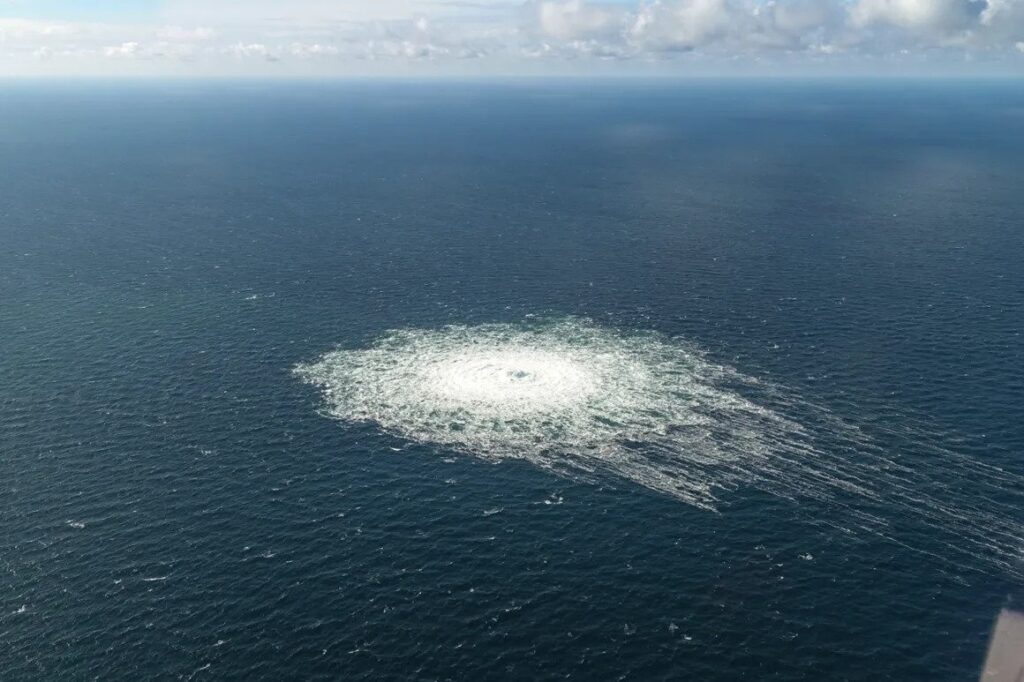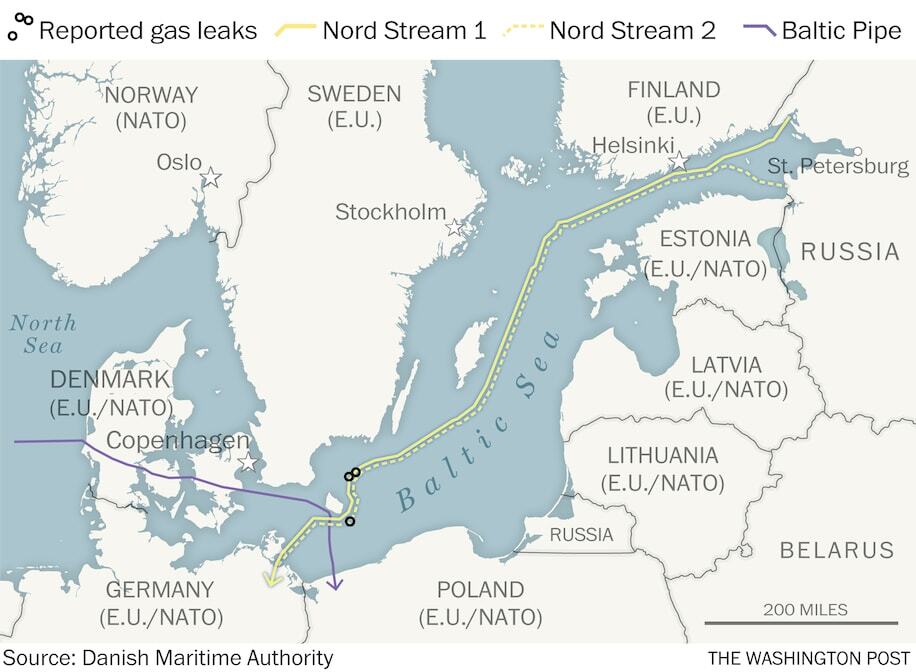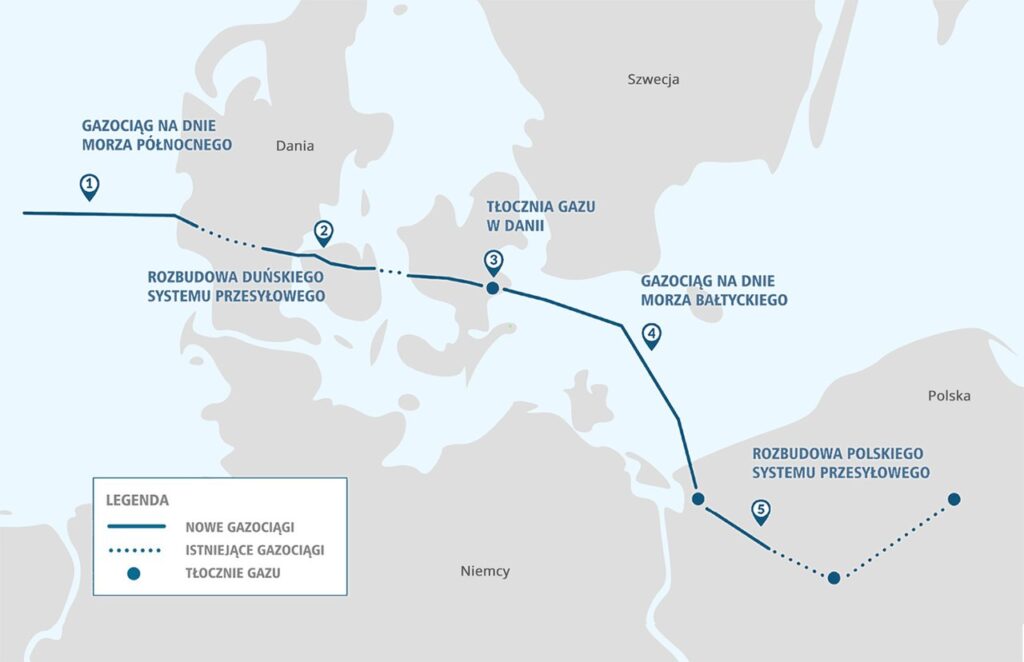“Once is happenstance. Twice is coincidence. The third time it’s enemy action”
– Ian Fleming, the British author who created James Bond

ABOVE: Major leaks were reported near the Nord Stream pipelines off the coast of Denmark’s Bornholm island.
Sources: Danish Defence Command and Swedish Defense Staff, plus imagery provided by Planet Labs, an Earth imaging company, which showed methane bubbles appearing on the surface as early as 9 a.m. Monday, following the first recorded blast.
28 September 2022 – As reported yesterday, the Sweden and Denmark defense departments reported multiple blasts on two of the Russia-to-Germany Nord Stream gas pipelines under the Baltic Sea. Scandinavian seismic stations detected explosions in the area around the time the leaks began.
Two of the leaks occurred near the double Nord Stream 1 pipeline, to the northeast of Denmark’s Bornholm island, and one leak was reported near the Nord Stream 2 pipeline off the southeastern coast of the island, the Danish Maritime Authority said on Tuesday. A spokesperson for the Danish Defense Command said that two of the leaks occurred in an area of the sea that is part of Denmark’s exclusive economic zone (EEZ) (but not in coastal territorial waters) and one occurred in Sweden’s EEZ.
Sweden’s national seismic network detected two distinct blasts in the area on Monday, one at 2:03 a.m. and the second at 7:04 p.m., reported national broadcaster SVT. The Geological Survey of Denmark and Greenland said it had recorded two “shaking” events corresponding to the time of reported gas leaks. The seismographic signals from both events “do not resemble signals from earthquakes. They do resemble the signals typically recorded from blasts,” the organization said.
A no-go zone of 5 nautical miles was established around each of the sites, which are at a likely depth of 60 meters to 70 meters, Baltic maritime agencies said.

“It is the authorities’ assessment that these are deliberate actions. It is not an accident,” Danish Prime Minister Mette Frederiksen said on Tuesday, hardening an assessment from earlier in the day. “The situation is as serious as it gets,” she added in remarks carried on Danish media. Swedish Prime Minister Magdalena Andersson agreed: “We have Swedish information and we have also been in touch with Denmark, and based on this, we have concluded that this is likely a deliberate act, that is, it is likely an act of sabotage.”
No one on the European side of the ocean is thinking this is anything other than Russian sabotage. And a NATO source told me it might actually have been a message to NATO: “We are close.” Another said that it could be a threat to other, non-Russian energy infrastructure, since so many pipelines crisscross the Baltic Sea, including the one inaugurated Tuesday.
But I also think that crucial internet data cables lie along the bottom of the sea, and there have been long-standing concerns that Russia has a submersible program that could cut them, causing communications chaos around the world.
These attacks put a glaring spotlight on the problem: Europe is crisscrossed by a web of thousands of miles of gas and oil pipelines, and even longer overhead electricity lines, linking hundreds of pumping stations, storage sites and power transformers. Hit one, either via cyberattack or physical sabotage, and the impact would reverberate across the continent. History suggests the risk of disruption from cyberattacks is real – and previous incidents suggests the energy network is far more vulnerable than governments acknowledge.
Nobody is ready to identify the culprit as Russia until submersible investigation equipment arrived at the locations. But it overshadowed the inauguration of a long-awaited pipeline that will bring Norwegian gas to Poland to bolster Europe’s energy independence from Moscow:

One does not need to be an avid reader of Cold War novels to see echoes of the adventures of 007 in the real-life events around these attacks. In a single day, the conduits, which link Russia with Germany under the Baltic Sea, have suffered not one, not two, but three separate major leaks. Three times, in three different places, all almost at the same time? Ian Fleming would deem this enemy action. So, of course, sabotage springs to mind. According to “The Moscow Rules“, there is no “if it feels wrong, it is wrong”, but there is “Never go against your gut”, which is basically the same. So many ask “What does Putin get out of this? How does forever cutting off a buyer for your goods help?”
But Putin is a madman, bent on creating chaos. In his world, as John Quinn observed on Linkedin, “logic isn’t politics and politics isn’t logic”.
European countries are scrambling to protect critical infrastructure this sabotage. Over the course of yesterday, and this morning, after multiple Western intelligence briefings, more and more leaders came to the same conclusion as Denmark’s Prime Minister : these were deliberate actions, not accidents.
Will the EU react? Can the EU react? European Commission President Ursula von der Leyen vowed that “any deliberate disruption of active European energy infrastructure is unacceptable and will lead to the strongest possible response.”
In the past, European leaders have been all too willing to ignore attacks by foreign governments on their own territory — think of the repeated explosions in arms depots in Bulgaria, or the murder in broad daylight in Berlin’s Tiergarten park in 2019, which a court said was ordered by the Russian state, or the Polonium and the Novichok poisonings in the U.K., which all were followed by little more than a slap on the wrist. Not exactly discouraging to any hostile nation that wants to cause havoc in Europe.
Even if the EU found out who was responsible, there is little the bloc could do in response to such sabotage, other than impose (more) economic sanctions. As told to me by several Western intelligence contacts, the main action was now with national governments and their security agencies.
For a union with some 450 million inhabitants and one of the world’s largest economies, it’s a testament to its weakness that when it is attacked, it has no way of investigating let alone retaliating, but instead has to rely on its national members. Or as Politico put it quite simply earlier this week, when will Europe learn to defend itself?
So now the race to secure infrastructure. Since yesterday, countries across Europe have been scrambling to secure their pipelines, cables, drilling platforms and LNG terminals, with officials warning that unidentified drones had been detected over Norwegian oil and gas platforms. Norway raised the security alert level around its platforms.
This morning I attended a Critical Energy Infrastructures (CEI) seminar which is a consortium of 18 leading CEI European technology vendors. They addressed multiple issues surrounding the prevention, detection, and response to the failure/attack on energy infrastructure. There are scores of technological innovations to safeguard CEI from cyber-physical-social threats. But (as always) the expert execution and speed of deploying them are paramount.
Some intel source said we may not get any hard evidence to tell who was responsible for the attacks, as they happened deep underwater, with one saying authorities would “maybe never” know with certainty.
THE BOTTOM LINE
But one thing is clear. The energy war just got really hot. As Elisabeth Braw (a Senior Fellow at AEI, specializing in defense against gray-zone aggression) noted on her blog last night:
“Leaking pipelines don’t constitute military aggression. Causing environmental damage constitutes cunning gray-zone aggression – and like all gray-zone aggression, it’s extremely difficult to counter. Causing environmental harm is, in fact, brilliant yet utterly cynical gray-zone aggression.
Damaging another country’s environment is easy, cheap, and can often be done without much risking one’s own habitat. With most of its coastline located elsewhere, Russia won’t suffer much if the Baltic Sea sustains environmental damage”.
Putin has invoked the nuclear specter in an effort to scare Western governments into ending their military support of Ukraine. But it hasn’t worked. So now Russia seems to be testing a new strategy: quietly causing harm to the Baltic Sea, a tiny ocean that is already extremely dirty. In addition to the damage done by commercial shipping, there’s the systematic flow of pollution from Kaliningrad. For years, and despite pleas by Russia’s Baltic Sea neighbors, the Russian exclave was simply pumping its sewage into the sea. In 2016, a sewage plant co-financed by the Swedish International Development Agency became operational—but most of the Baltic Sea’s environmental-damage hotspots remain located off Kaliningrad and St. Petersburg.
Methane, of course, pollutes the air far more than the water – and by releasing the dangerous gas Moscow appears to be signaling that it’s willing to harm not just its neighbors but the rest of the world too. Leaking gas could cause an explosion. No traffic should be allowed in the vicinity of the affected area.
And so a new front in the Ukraine War and a further attack on Europe. The lesson is clear: the energy war is ongoing, winter is about to start, and Putin will continue to play dirty.